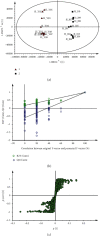Chemical Comparison of White Ginseng before and after Extrusion by UHPLC-Q-Orbitrap-MS/MS and Multivariate Statistical Analysis
- PMID: 33083092
- PMCID: PMC7563053
- DOI: 10.1155/2020/4764219
Chemical Comparison of White Ginseng before and after Extrusion by UHPLC-Q-Orbitrap-MS/MS and Multivariate Statistical Analysis
Abstract
Ultrahigh-performance liquid chromatography Quadrupole-Orbitrap tandem mass spectrometry (UHPLC-Q-Orbitrap-MS/MS) was used to compare the composition of ginsenosides in white ginseng (WG) and extruded white ginseng (EWG). A total of 45 saponins, including original neutral ginsenosides, malonyl-ginsenosides, and chemical transformation of ginsenosides, were successfully identified in both WG and EWG. Multivariate statistical analyses including supervised orthogonal partial least squared discrimination analysis (OPLS-DA) and hierarchical clustering analysis (HCA) were used to analyze components of white ginseng before and after extrusion. As a result, three ginsenosides (malonyl (M)-Rb1, M-Rb2, and M-Rc) were found to be increased in WG, while three ginsenosides (Rb2, Rc, and Rg1) were elevated in EWG. In the OPLS-DA S-plot, the different compositions of ginsenoside that were distinguished between WG and EWG were screened out. Experimental results indicate that the UHPLC-Q-Orbitrap-MS/MS is a useful tool to characterize variations of ginsenosides in WG and EWG.
Copyright © 2020 Yun-Long Guo et al.
Conflict of interest statement
The authors declare that they have no conflicts of interest.
Figures




Similar articles
-
Comparison of the Saponins in Three Processed American Ginseng Products by Ultra-High Performance Liquid Chromatography-Quadrupole Orbitrap Tandem Mass Spectrometry and Multivariate Statistical Analysis.Int J Anal Chem. 2022 Apr 26;2022:6721937. doi: 10.1155/2022/6721937. eCollection 2022. Int J Anal Chem. 2022. PMID: 35521625 Free PMC article.
-
Saponin composition comparison of black ginseng and white ginseng by liquid chromatography-mass spectrometry combined with multivariate statistical analysis.Nat Prod Res. 2023 Oct-Nov;37(19):3297-3301. doi: 10.1080/14786419.2022.2062352. Epub 2022 Apr 14. Nat Prod Res. 2023. PMID: 35422187
-
Chemical Comparison of Two Drying Methods of Mountain Cultivated Ginseng by UPLC-QTOF-MS/MS and Multivariate Statistical Analysis.Molecules. 2017 Apr 30;22(5):717. doi: 10.3390/molecules22050717. Molecules. 2017. PMID: 28468295 Free PMC article.
-
Profiling and multivariate statistical analysis of Panax ginseng based on ultra-high-performance liquid chromatography coupled with quadrupole-time-of-flight mass spectrometry.J Pharm Biomed Anal. 2015 Mar 25;107:141-50. doi: 10.1016/j.jpba.2014.12.030. Epub 2014 Dec 26. J Pharm Biomed Anal. 2015. PMID: 25590943
-
A comparative study on chemical composition of total saponins extracted from fermented and white ginseng under the effect of macrophage phagocytotic function.J Ginseng Res. 2017 Jul;41(3):379-385. doi: 10.1016/j.jgr.2017.03.009. Epub 2017 Mar 31. J Ginseng Res. 2017. PMID: 28701881 Free PMC article. Review.
Cited by
-
Evaluation of storage period of fresh ginseng for quality improvement of dried and red processed varieties.J Ginseng Res. 2022 Mar;46(2):290-295. doi: 10.1016/j.jgr.2021.06.007. Epub 2021 Jun 23. J Ginseng Res. 2022. PMID: 35509815 Free PMC article.
-
Comparison of the Saponins in Three Processed American Ginseng Products by Ultra-High Performance Liquid Chromatography-Quadrupole Orbitrap Tandem Mass Spectrometry and Multivariate Statistical Analysis.Int J Anal Chem. 2022 Apr 26;2022:6721937. doi: 10.1155/2022/6721937. eCollection 2022. Int J Anal Chem. 2022. PMID: 35521625 Free PMC article.
-
UHPLC-HRMS based saponins profiling of three morphological regions in American ginseng (Panax quinquefolium L.) and their correlation with the antioxidant activity.Food Sci Biotechnol. 2023 Nov 28;33(7):1685-1696. doi: 10.1007/s10068-023-01453-4. eCollection 2024 Jun. Food Sci Biotechnol. 2023. PMID: 38623439 Free PMC article.
-
In Vitro Biotransformation of Total Glycosides in Qiwei Baizhu Powder by the Gut Microbiota of Normal and Diarrheal Mice: Novel Insight Into the Biotransformation of Multi-Glycosides by the Gut Microbiota.Front Chem. 2022 Jun 20;10:907886. doi: 10.3389/fchem.2022.907886. eCollection 2022. Front Chem. 2022. PMID: 35795223 Free PMC article.
-
Rapid Identification of Characteristic Chemical Constituents of Panax ginseng, Panax quinquefolius, and Panax japonicus Using UPLC-Q-TOF/MS.J Anal Methods Chem. 2022 Feb 15;2022:6463770. doi: 10.1155/2022/6463770. eCollection 2022. J Anal Methods Chem. 2022. PMID: 35340764 Free PMC article.
References
-
- Kim B.-G., Choi S.-Y., Suh H. J., Park H. J. Bitterness reduction and enzymatic transformation of ginsenosides from Korean red ginseng (panax ginseng) extract. Journal of Food Biochemistry. 2011;35(4):1267–1282. doi: 10.1111/j.1745-4514.2010.00450.x. - DOI
LinkOut - more resources
Full Text Sources
Research Materials
Miscellaneous

